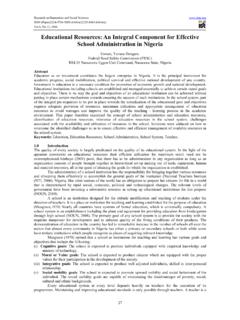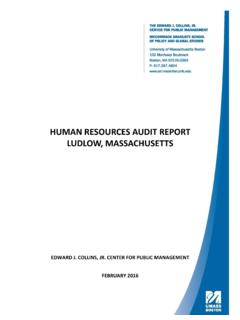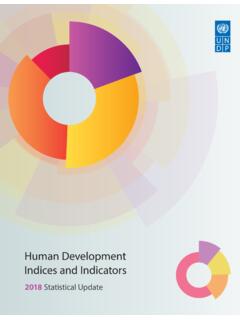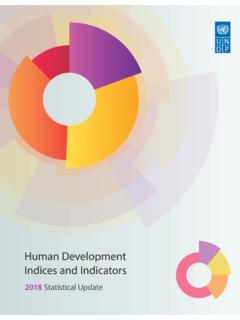Transcription of A Note from
1 A Note from EPA administrator Michael S. ReganFor far too long, communities across the United States have been suffering from exposure to PFAS pollution. As the science has continued to develop, we know more now than ever about how PFAS build up in our bodies over long periods of time, and how they can cause adverse health effects that can devastate families. As Secretary of the North Carolina Department of Environmental Quality, I saw this devastation firsthand. For years, the Cape Fear River had been contaminated by these persistent forever chemicals.
2 As I spoke with families and concerned citizens, I could feel their suffering and frustration with inaction. I knew my job was going to be trying and complex. But we were able to begin to address this pervasive problem by following the science, following the law, and bringing all stake-holders to the one of my earliest actions as EPA administrator , I established the EPA Council on PFAS and charged it with developing an ambitious plan of action to further the science and research, to restrict these dangerous chemicals from getting into the envi-ronment, and to immediately move to remediate the problem in communities across the country.
3 EPA s PFAS strategic roadmap is our plan to deliver tangible public health benefits to all people who are impacted by these chemicals regardless of their zip code or the color of their I ve been EPA administrator , I have become acutely aware of the invaluable and central role EPA has in protecting public health in America. For more than 50 years, EPA has implemented and enforced laws that protect people from dangerous pollution in the air they breathe, the water they drink, and the land that forms the foundation of their communities.
4 At the same time, my experience in North Carolina reinforced that EPA cannot solve these challenges alone. We can only make progress if we work in close collaboration with Tribes, states, localities, and stakeholders to enact solutions that follow the science and stand the test of time. To affect meaningful change, engagement, transparency, and accountability will be critical as we move roadmap will not solve our PFAS challenges overnight. But it will turn the tide by harnessing the collective resources and authority across federal, Tribal, state, and local governments to empower meaningful action want to thank the co-chairs of the EPA Council on PFAS Radhika Fox, Assistant administrator for Water, and Deb Szaro, Acting Regional administrator in Region 1 for their leadership in guiding the development of this s get to Michael S.
5 Regan PFAS Strategic Roadmap: EPA s Commitments to Action 2021 2024 1 PFAS Council MembersThe following policy and technical leaders serve as members of the EPA Council on PFAS. They have been instrumental in working with their respective offices to develop the Agency s strategy. The Council will continue to coordinate across all EPA offices and Regions to accelerate progress on Fox, Assistant administrator for WaterDeb Szaro, Acting Regional administrator , Region 1 Office of the AdministratorJohn Lucey, Special Assistant to the AdministratorAndrea Drinkard, Senior Advisor to the Deputy AdministratorOffice of Air and RadiationJohn Shoaff, Director, Air Policy and Program SupportOffice of Chemical Safety and Pollution PreventionJeffrey Dawson, Science AdvisorTala Henry.
6 Deputy Director, Pollution Prevention and ToxicsOffice of Enforcement and Compliance AssuranceCyndy Mackey, Director, Site Remediation EnforcementKarin Leff, Director, Federal Facilities EnforcementOffice of General CounselDawn Messier, Deputy Associate General Counsel, WaterJen Lewis, Deputy Associate General Counsel, Solid Waste and Emergency ResponseOffice of Land and Emergency ManagementDana Stalcup, Deputy Director, Superfund Remediation and Technology InnovationDawn Banks, Director, Policy Analysis and Regulatory ManagementOffice of Research and DevelopmentTim Watkins, Acting Director, Center for Public Health and Environmental AssessmentSusan Burden, PFAS Executive LeadOffice of WaterJennifer McLain, Director, Ground Water and Drinking WaterDeborah Nagle, Director, Science and TechnologyZachary Schafer, Senior Advisor to the Assistant AdministratorEPA RegionsJohn Blevins, Acting Regional administrator , Region 4 Tera Fong, Water Division Director, Region 52 PFAS Strategic Roadmap.
7 EPA s Commitments to Action 2021 Agency s Approach ..6 Goals and Objectives ..9 Key Actions ..23 PFAS Strategic Roadmap: EPA s Commitments to Action 2021 2024 3 IntroductionHarmful per- and poly-fluoroalkyl substances (PFAS) are an urgent public health and environmental issue facing communities across the United States. PFAS have been manufactured and used in a variety of industries in the United States and around the globe since the 1940s, and they are still being used today. Because of the duration and breadth of use, PFAS can be found in surface water, groundwater, soil, and air from remote rural areas to densely-pop-ulated urban centers.
8 A growing body of scientific evidence shows that exposure at certain levels to specific PFAS can adversely impact human health and other living things. Despite these concerns, PFAS are still used in a wide range of consumer products and industrial level of government federal, Tribal, state, and local needs to exercise increased and sus-tained leadership to accelerate progress to clean up PFAS contamination, prevent new contami-nation, and make game-changing breakthroughs in the scientific understanding of PFAS.
9 The EPA Council on PFAS developed this strategic road-map to lay out EPA s whole-of-agency approach to addressing PFAS. To deliver needed protections for the American people, the roadmap sets time-lines by which the Agency plans to take specific actions during the first term of the Biden-Harris Administration. The strategic roadmap builds on and accelerates implementation of policy actions identified in the Agency s 2019 action plan and commits to bolder new policies to safeguard public health, protect the environment, and hold polluters risks posed by PFAS demand that the Agency attack the problem on multiple fronts at the same time.
10 EPA must leverage the full range of statutory authorities to confront the human health and eco-logical risks of PFAS. The actions described in this document each represent important and meaningful steps to safeguard communities from PFAS con-tamination. Cumulatively, these actions will build upon one another and lead to more enduring and protective s integrated approach to PFAS is focused on three central directives: Research. Invest in research, development, and innovation to increase understanding of PFAS exposures and toxicities, human health and ecological effects, and effective interventions that incorporate the best available science.



















